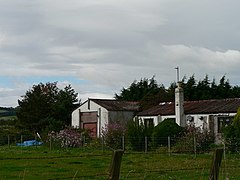Milfield

| Milfield | |
|---|---|
 Old RAF Buildings, Milfield | |
Location within Northumberland | |
| Population | 315 (2011 census)[1] |
| OS grid reference | NT935335 |
| District | |
| Shire county | |
| Region | |
| Country | England |
| Sovereign state | United Kingdom |
| Post town | WOOLER |
| Postcode district | NE71 |
| Police | Northumbria |
| Fire | Northumberland |
| Ambulance | North East |
| UK Parliament | |
Milfield is a village in Northumberland, England about 3 miles (5 km) northwest of Wooler. The A697 road passes through the village.
History
[edit]Milfield is the likely location of the Northumbrian royal settlement of Maelmin. Bede tells us that a residence was built at Maelmin to supersede Edwin of Northumbria's residence of Ad-Gefrin at Yeavering.[2] Evidence of a high-status Anglo-Saxon settlement at Milfield strongly suggests that this is the location of Maelmin, because of its proximity to Yeavering.[3] Maelmin has been identified as a Brittonic place name with a probable meaning of 'decayed edge',[4] though other Brittonic etymologies are also possible.[5]
On Milfield Plain, which is part of the bed of the prehistoric Lake of Glendale, was fought one of the many battles between Scots and English. In the month before the Battle of Flodden, some Scots, under Alexander Home, 3rd Lord Home, were returning from a raid into England where they had burnt several villages. Laden with booty which they had "lifted", Home's men were surprised by a band of English under Sir William Bulmer of Brancepeth in County Durham. The Durham men were victorious and for long years afterwards the Scots name for the road through Milfield was "The Ill Road". Many years after the rout of Home's men, General Monk waited at Milfield with his forces before his momentous march south which brought about the Restoration.[6]
During the Second World War, an air training unit operated from the nearby RAF Milfield.
Notable people
[edit]One of Northumberland's most notable daughters, Josephine Grey, the social reformer, was born at Milfield House, about six miles from Wooler. This woman, who did so much valuable work in the nineteenth century to combat the social evils of the day, is more generally known by her married name of Butler. A college was named after her at Durham University and a residency block there was named Milfield in honour of her birthplace. At the end of her long life she returned to her beloved Northumberland and is buried in Kirknewton churchyard under the shadow of Yeavering Bell.[6]
References
[edit]- ^ "Parish population 2011". Retrieved 3 July 2015.
- ^ Bede (1982) [1955]. A History of the English Church and People. Translated by Leo Sherley-Price. Harmondsworth, Middlesex, United Kingdom: Penguin Classics.
- ^ Waddington, Clive (2001). Maelmin: An Archaeological Guide. Milfield, Northumberland, United Kingdom: CS Publishing.
- ^ Breeze, Andrew (2001). "The Name of Maelmin, near Yeavering". Archaeologica Aeliana. 29: 31–32.
- ^ Bethany Fox, 'The P-Celtic Place-Names of North-East England and South-East Scotland', The Heroic Age, 10 (2007), appendix.
- ^ a b Ridley, Nancy (1966). Portrait of Northumberland (reprint ed.). London: Robert Hale. OCLC 503957631.
External links
[edit]- Northumberland Communities (Accessed: 27 November 2008)
